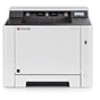Kyocera ECOSYS P5021cdw ECOSYS M5526/M5521/P5021/P5026 Series Printer Driver U - Page 69
Setting a Default Color Profile, Windows 10, Windows Server 2012 R2
 |
View all Kyocera ECOSYS P5021cdw manuals
Add to My Manuals
Save this manual to your list of manuals |
Page 69 highlights
Printer Driver Imaging This option optimizes for color contrast by adjusting contrast to preserve detail throughout the tonal range. Select it for images or scanned photographs containing many colors or shades of color. Optimize for color saturation (best for graphs) This option optimizes for color saturation by adjusting hue to preserve the vividness of pure colors. Select for graphs or charts containing solid colors. 3 Click OK again to close the Color Correction dialog box. Setting a Default Color Profile Windows 10, Windows 8.1, Windows Server 2012 R2, Windows 8, Windows Server 2012, Windows 7, Windows Vista, Windows Server 2008, and Windows Server 2008 R2 1 Depending on your operating system: Windows 10, Windows 8.1, and Windows Server 2012 R2: right-click Start > Control Panel > View devices and printers. Windows 8 and Windows Server 2012: open Control Panel > View devices and printers. Windows 7 and Windows Server 2008 R2: click Start > Devices and Printers. Windows Vista and Windows Server 2008: click Start > Control Panel > Printer. 2 Right-click your color model, then: Windows 10, Windows 8.1, Windows Server 2012 R2, Windows 8, Windows Server 2012, Windows 7, and Windows Server 2008 R2: click Printer properties. Windows Vista and Windows Server 2008: click Properties. 3 Select the Color Management tab and click Color Management. 4 In the Devices tab > Device list, select the desired color printer. 5 Select the Use my settings for this device check box. 6 In the Profile selection list, select Manual, and click Add. 7 In the Associate Color Profile dialog box, select an ICC profile, or click Browse to find a profile, and click OK. The profile is added to the Profiles associated with this device list. 8 Select the desired color profile and click Set as Default Profile. 9 Click Close. Windows XP and Windows Server 2003 1 Click Start, and then click Printers and Faxes. 7-9















